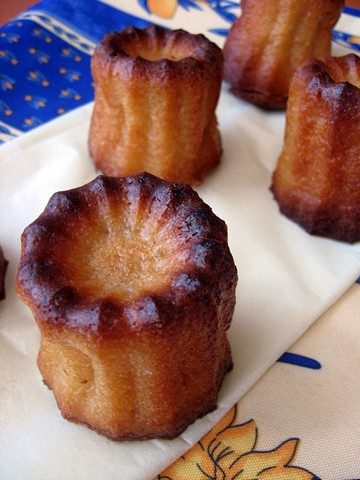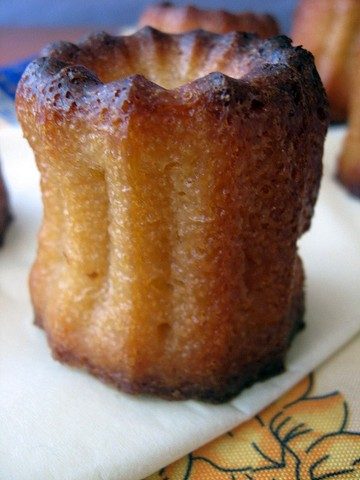Have you heard of Canelés? Are they a mystery to you? Well l would not be surprised if you have not, they have been wrapped in mystery since the day they were invented. Like a spy in a cloak this French pastry has slipped in and out of history for 3 centuries, not leaving many clues behind.
I first came across them about a year ago when the social media firm Télégraphe hosted a friendly Canelé blind test competition, an excuse to get together. I found it funny taste testing and grading an unknown sweet treat. But I fell in love with them right away…and also swore at first I would NOT attempt to make them. Well only fools don’t change their minds, right?
Canelés (also often misspelled Cannelés) are a specialty of the Bordeaux region of France. This “cake” is traditionally baked in a small, striated cylinder mold and is characterized by a soft and tender custard center with a dark, thick caramelized crust. The recipe mostly consists of eggs, sugar, milk, flour, rum and vanilla mixed into a light crepe-like batter that is left to rest for 48 hours in the fridge. And they are A-D-D-I-C-T-I-V-E.
Legend has it that Canelés were created and invented in the 18th century by the nuns of the convent of Annonciades in Bordeaux. They were so popular that artisan bakers popped up in the streets selling their Canelé version. These special bakers were given the name “Canauliers” and registered a Guild with the Parliament of Bordeaux in 1663. During 19th century Canauliers disappeared from the artisans list of Bordeaux. In the first quarter of the 20th century the Canelé reappears. It is likely that its current shape comes from the similarity (in French) of the word wave with the word “cannelure” (fluting, corrugation, striations). wiki
And the mystery keeps persisting. I wish I could give you a source for my recipe but honestly I cannot. I have tweaked my proportions by comparing about 6-8 different recipes. No two are the same, so I am calling this version my own, adapted from the original recipe that no one seems to own (supposedly stored in a safe in France and known by only a very few pastry chefs who have been sworn to secrecy). Let’s investigate the sweet conspiracy…
Canelés Bordelais
Ingredients:
500 ml (2 cups) whole milk
25 g (2 oz) butter
2 egg yolks
1 whole egg
255 g (9 oz) sugar
1 pinch of salt
1 teaspoons vanilla extract or seeds from 1 vanilla pod
30ml (1/8 cup) rum
140 g (5 oz) flour
Directions:
- Heat milk to 183°F on the stove, add the butter and let it cool completely to room temperature.
- In a bowl, beat together the yolks, eggs, sugar, salt, vanilla and rum.
- Incorporate the flour. Mix well then mix in the cooled milk gradually.
- Let the batter rest (it will be very fluid), covered, in the fridge for 48 hours.
- Fill the Canelés molds almost to the top.
- Bake in a preheated oven at 450°F (230°C) for 15min, then lower to 375°F (180°C) and bake for 1 hour or until they are a dark golden brown.
- Remove from mold immediately and absolutely let them cool before eating.
Makes 12 big Canelés (2″ x 2″ mold)
Notes:
– It is important to cool completely the milk mixture before pouring it over the egg mixture otherwise it could “cook” the dough.
– YES let the batter rest for 48 hours. No ifs or buts…DO NOT skip this step.
– This recipe specifies cooking times for the big Canelé mold where the cavity dimensions are 2″ x 2″.
– Break with tradition: try other alcohols or liqueurs. I only make mine with absinthe now if I have it in my bar. Awesome!

– The traditional recipe calls for tin-lined copper mold. Prepare to pay about $20 a piece. A better option is purchasing a Canelé silicone mold which is still not cheap ($30 to 40) unless you get lucky on Ebay like I did.
Before investing in a Canelé mold I did try out the recipe in a muffin mold. They totally loose their presentation charm, actually probably closer to what they looked like in the 18th century, but the taste was unchanged. You can see them below. Look at the custard-like insides here. This dessert is heaven!






Having the right fluted mold certainly helps a lot with the cooking but you can experiment with other small molds
I have always wanted to try this. Do you need to use that mold?
Wow..I’m late to this one! I’ve been so bogged down with stuff, I can’t even think straight. I’ve never had caneles, but they look and sound exactly like something I’d love. Custardy? I’m a custard nut, so sign me up!
This looks really really yummy. The nuns uses rum in their desserts?
I’ve never heard of them, but they look so delicous! Thanks for sharing :))
I never even heard of caneles…but from your description they sure must taste delicious, love the custard inside and the caramel crust outside. Nice pictures! Have a great week Evelyne 🙂
They sound delicious! I’ve never heard of them, but I would love to have a bite right about now. 🙂
Love that mold!!
These look familiar…I may have had these before in France. My memory tells me that yes, they taste as gorgeous as you’d described! When I saw their fluted shapes, I wanted to know where you got your molds. Then I read further and you mentioned eBay so I’m going over to check it out. I’m so craving that custardy insides now!
Those look absolutely wonderful, I’ve tried them before but never made them, I should totally get that mold!
I’ve never heard of them before, but I sure would love to try them! I’m sure this dessert is heavenly…especially since it has rum in it! 🙂
I have never had these before, but they sound delicious! They look so cute and moist!
I have never heard of these before. Oh they look good….lovely texture and shape.
Whoa, I’m an idiot. I have seen these around quite a few times but never had one. So many waster opportunities! I didn’t know they were custardy inside, what a fool I am!
Those look so good Evelyne. I bet the taste was great! I can never turn something like this down.
You know, the ones I have tried have not impressed me. They have always been dry and chewy. Your’s look moist fluffy and delish.
Yum! I love caneles, even though I can’t spell/accent it properly. I walked all over San Francisco, looking for a famous canele, and it was totally worth it! I love custardy desserts. Hey, I’ll be in Montreal for the tennis finals in August–hope to see you then!
🙂
I love caneles as well! How lucky that you have a mold… Best, sandie
I loooooove canelés! I used to eat them in Belgium all the time, and Pâtisserie de Gascogne make decent ones here. I’ve been meaning to make them forever, got the mold and everything. Yours look perfect, way to go!
They ARE addictive aren’t they? I love canelés! So glad you gave them a try! 🙂